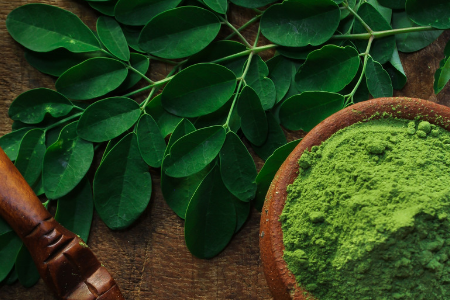Moringa oliefera has recently become a very popular superfood. It is loaded with plenty of beneficial nutrients that strengthen and heal the body. Although superfood trends come and go, Moringa is here to stay as a top resource for life-changing benefits.
Moringa, also known as the “Tree of Life”, is a plant that is highly regarded for its miraculous effects on the body. Moringa oleifera is the most widely cultivated species of the genus Moringa. The tree is native to tropical and subtropical regions of India, Pakistan, Bangladesh, and Afghanistan. Moringa is cultivated around the world and thrives best in dry and sandy soils. For thousands of years, Moringa leaves, bark, roots, flowers, pods and seeds have been used to treat various ailments. In many countries, Moringa is used to fortify foods and supplement baby food to combat malnutrition.
Moringa is a safe, natural, and effective source for healing. If you couldn’t decide which superfood path to follow, Moringa is the way to go! Here are some of the top reasons why Moringa oleifera should be incorporated into your diet.

Dense Nutrient Content
Moringa oliefera is one of the most useful trees in the world. Considering the extensive nutritional profile and powerful medicinal properties, it is no surprise why this plant is viewed as a tree of miracles.
The entire moringa plant is used for nutritional and medicinal purposes. However, the leaves contain the greatest concentrations of nutrition. Moringa leaves are a great source of many vitamins and minerals. The density of nutrients in the leaves alone can provide enough reason for anyone to want to use this plant as replacement for the beloved kale or spinach.
Rich in Antioxidants
Antioxidants are compounds that slow down cell damage caused by oxidation. Oxidation is a process by which free radicals are formed as oxygen reacts with different molecules such as sugars, fatty acids, and amino acids. As oxygen reacts in the body, these molecules lose electrons and very unstable molecules are created. The unstable molecules are called free radicals. Increased free radical formation in the body can lead to infection and degenerative conditions such type 2 diabetes and heart disease.
Moringa oliefera contains many antioxidants such as gallic acid, quercertin, flavanoids, chologenic acid, and ascorbic acid. These compounds collectively are a potent group of antioxidants that work towards protecting the cell and preventing oxidative damage.
These antioxidants improve brain health, support the liver, and regulate oxidative damage in diabetic patients.
Lowers Inflammation
Inflammation occurs when the immune system becomes activated after injury or invasion from foreign substances. It occurs in efforts to heal and protect the body.
However, persistent inflammation is not normal and can lead to heart disease, cancer, autoimmune disorders, and type 2 diabetes.
Compounds found in moringa leaves, pods, and seeds can potentially reduce inflammation in the cells.
Promotes Weight Loss
Many people have reported weight loss with consistent use of M. oleifera in its many forms. This effect may be due to the following factors:
- High amounts of fiber. Fiber, specifically soluble fiber, is known to decrease appetite and reduce the cravings that lead to weight gain. Remember to incorporate plenty of soluble fiber in your diet. Healthy sources include: black beans, broccoli, pears, apples, sweet potato, flaxseeds, and carrots.
- Rich Antioxidant content. Antioxidants, specifically flavonoids, help curb the belly bulge by boosting the body’s metabolic processes. As a result, one may witness signs of reduced aging, inflammation, and cellular damage.
- Metabolism-stimulating properties. Moringa has a high concentration of sulfur-containing compounds called glucosinolates and isothiocyanates. Glucosinolates and isothicyanate are phytochemicals that are typically found in cruciferous vegetables like broccoli, kale, and cabbage. When we eat moringa and cruciferous vegetables, these phytochemicals break down into smaller molecules that increase the efficiency of how the body breaks down the foods that are consumed. This increased efficiency will also lead to improved insulin sensitivity and weight loss.
How to Add Moringa to Your Diet
Moringa is available in many forms including: fresh leaves, dried leaves, powder, extract, tea, and capsules. Whichever form you decide to purchase, make sure the product is 100% pure Moringa oleifera.
Please keep in mind that although moringa can help you reach your health goals, you must do your part to support the body’s natural healing process. Regularly exercising, eating a whole foods, plant-based diet, and getting at least six hours of sleep are all puzzle pieces to your personal overall wellness.
Consuming moringa on a regular basis will provide healthy and wholesome nutrients that will naturally recharge the body and clear out the toxins that are weighing you down.

